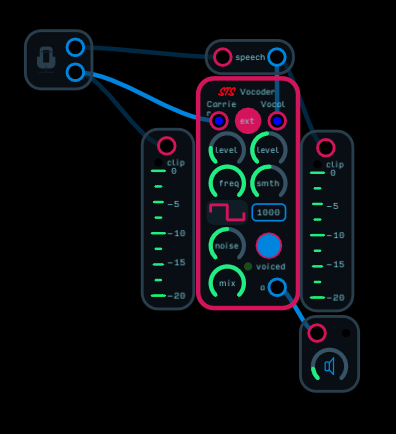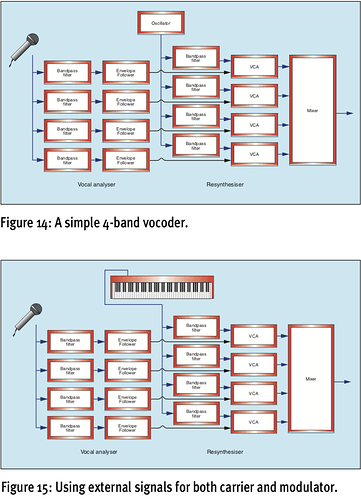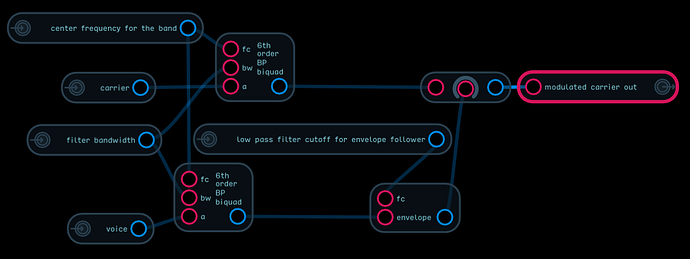Hey everyone! I was reading through the Synth Secrets articles that I was recommended, and when I got to the chapter on vocoders, I was pretty interested in that concept, and I’m sure there is a way to make one using Audulus. The problem I am having is, I don’t know how to go about making or representing a pitch/CV converter, as I understand that is a part of the device pictured below. Although it is not directly in the picture, the article makes it pretty clear that it is a very important component in there somewhere. Does anyone have any ideas how to do this? I searched the forum, and couldn’t find anything, unless I am using the wrong word and it is known by another term now…
I made these a while back but never posted them on the new forum. The first one is the completed 16 band version using 4th order bi-quad based filters and the second is an 8 band version which I never put inside a module. On the 16 band you can use an internal or external carrier. There’s a smoothing filter for the voice, and a switchable sibilance detector with a noise source. This is an instagram video of an earlier model:
https://www.instagram.com/p/BeTy3J4nS7U/?utm_source=ig_web_button_share_sheet\

16 band vocoder V1.1.audulus (1021.2 KB)
8 band vocoder biquad.audulus (481.8 KB)
Thanks for the response! Your patches are amazing. I was wondering though, if you might have the time to basically dumb down the mechanics of how you went about building the inner workings of each, as I had a microphone attached to linear VCA, with HPF and LPF next, and then an oscillator, and I thought I was getting close somehow, but it seems I was not even in the ballpark lol. If not, no worries, but if you have the time to explain to someone who isn’t an audio engineer, it would sure be appreciated! 
A vocoder is basically two sets of bandpass filters. Each set starts with a low-pass filter for the low end, a number of bandpass filters with increasing center frequencies, and a high-pass filter at the top. Each set of filters will divide the frequency spectrum into a set of overlapping bands. You feed the voice signal into one set, which splits the voice signal into bands and then use an envelope follower to measure how much energy is in each band. You feed the carrier audio into the other set of filters which splits it. The output of the envelope follower for each voice band controls the gain of each filter band for the carrier. You mix the output of the carrier bands back together and you have a basic vocoder. The more bands you have and the steeper the filter cutoff, the better the effect.
The carrier can be a simple waveform, but it should have plenty of harmonic content like a square or saw. Often you use an external audio signal for a carrier like a guitar or keyboard. You can improve the intelligibility of the output by including a sibilance detector for sounds like “s” and feeding some noise into the mix when you detect sibilance. The detector works by comparing the high and low frequency parts of the sound and if the high frequencies are stronger it’s unvoiced (sibilance)
I can’t for the life of me seem to get the 16 band vocoder to work. As soon as I turn the mix full hard right I get no sound.
I got it to work by activating the voiced mode (the toggle trigger), setting the smth knob to any possition that isn’t completely left/0 and setting both levels at max (the vocoder makes the signal quite a lot quieter)
16 Band Vocoder.audulus (1.0 MB)
Are you using the internal carrier or an external carrier signal? Are you using a mic for the vocal signal? How does the mic level look?
I modded it slightly to increase the maximum gain on both the carrier and vocal inputs.
16 band vocoder V1.2.audulus (1021.4 KB)

